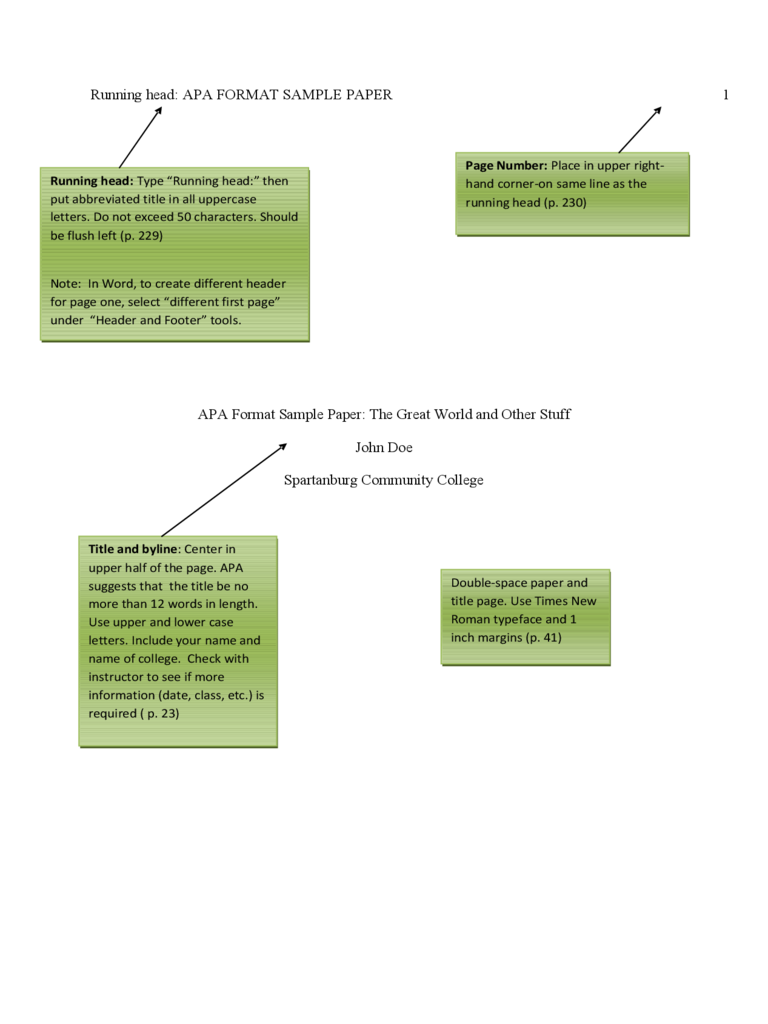Fillable Printable APA Format Sample Paper
Fillable Printable APA Format Sample Paper

APA Format Sample Paper

Running head: APA FORMAT SAMPLE PAPER 1
APA Format Sample Paper: The Great World and Other Stuff
John Doe
Spartanburg Community College
Running head: Type “Running head:” then
put abbreviated title in all uppercase
letters. Do not exceed 50 characters. Should
be flush left (p. 229)
Note: In Word, to create different header
for page one, select “different first page”
under “Header and Footer” tools.
Title and byline: Center in
upper half of the page. APA
suggests that the title be no
more than 12 words in length.
Use upper and lower case
letters. Include your name and
name of college. Check with
instructor to see if more
information (date, class, etc.) is
required ( p. 23)
Page Number: Place in upper right-
hand corner-on same line as the
running head (p. 230)
Double-space paper and
title page. Use Times New
Roman typeface and 1
inch margins (p. 41)

APA FORMAT SAMPLE PAPER 2
Abstract
An abstract is a brief summary of your paper. According to the APA manual, your abstract
should be a single paragraph in block format and between 150 and 250 words (p. 25-27; 41;
229). Your instructor will let you know if an abstract is required for your assignment.
Page header: The abbreviated title
from the running head is included
with the page # for page 2+. Put the
title flush left.

APA FORMAT SAMPLE PAPER 3
APA Format Sample Paper: The Great World and Other Stuff
The world is full of interesting trivia. For example, events in history often have strange back
stories. When Darwin sent a copy of The Origin of Species to an important British publisher, the
editor said the book would not sell. He advised Darwin to write a nice book on pigeons because,
of course, everyone likes pigeons (Bryson, 2003, p. 381). Names are also interesting. The
“Yippies” were a short lived group in the 60’s who staged some poorly planned protests
(Holloway, 2000). Even animals have strange names. For instance, a cat encyclopedia describes
a Ragdoll as a cat, not a toy (“Ragdoll,” 1997).
Not all the stories about names are believable, though. In his book, A Short History of Nearly
Everything, Bryson (2003) tells how explorers told strange tales of the “homo caudatus” or “man
with a tail” (p. 382). Just as strange are some of local laws. For example, according to one source
(James, 2003), it is illegal to walk around in high-heeled shoes in Carmel-by-the Sea, California.
Places are also interesting. One science website (Loveridge, 2004, para. 2) mentions how a
person can “see both the Atlantic and Pacific oceans on a clear day from the Republic of
Panama.” Fairy tales and nursery rhymes are particularly rich in odd information. For example,
one scholar (Honeyman, 2007) has analyzed the symbolism of gingerbread in tales such as
“Hansel and Gretel” and found that, among other things, it symbolizes temptation. This is very
interesting, considering we now live in a society where food is used for more than nourishment
and candy is advertised to parents as a way of “showing affection” to their children (Schwartz,
Chen, & Brownell, 2003, p. 207). Besides their symbolism, the origins of nursery rhymes are
also interesting. According to legend, the Man in the Moon was placed in the moon as
punishment for “collecting sticks on Sunday” (“The Man,” 2003, para. 12). So a lot of
interesting, if useless, information can be discovered in the most unlikely of places.

APA FORMAT SAMPLE PAPER 4
References
Bryson, B. (2003). A short history of nearly everything. New York, NY: Broadway Books.
Holloway, D. (2000). Yippies. In T. Pendergast & S. Pendergast (Eds.), St. James encyclopedia of popular
culture (Vol. 5, pp. 214-215). Detroit, MI: St. James Press.
Honeyman, S. (2007). Gingerbread wishes and candy (land) dreams: The lure of food in cautionary tales
of consumption. Marvels & Tales, 21, 195-216. Retrieved from http://www.langlab.wayne.edu/
MarvelsHome/Marvels_Tales.html
James, T. (2003, March). Little known foot laws. Podiatry Management, 22, 143-145. Retrieved from
http://www.podiatrym.com
Loveridge, J. (2003, October 21). The middle man. Retrieved from Reed Business Information website:
http://www.newscientist.com/lastword/article.jsp?id=lw498
The man in the moon. (2003). Retrieved from http://nurseryrhymes.allinfoabout.com
Ragdoll. (1997). In B. Fogle, (Ed.), The encyclopedia of the cat (pp. 112-113). New York, NY: D.K.
Schwartz, M., Chen, E., & Brownell, K. (2003). Trick, treat, or toy: Children are just as likely to choose
toys as candy on Halloween. Journal of Nutrition Education & Behavior, 35, 207-209.
doi:10.1016/S1499-4046(06)60335-7



